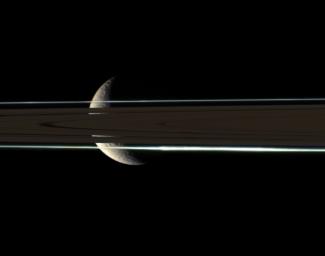
|
Coy Rhea
- Click the image above for a larger view
- Full-Res JPEG (751 x 593) (16.0 kB)
- Full-Res TIFF (751 x 593) (1.3 MB)
Caption:
The rings cannot hide the ragged, icy crescent of Rhea, here imaged in color by the Cassini spacecraft. The second-largest moon of Saturn shines brightly through gaps in the rings.
Rhea (1,528 kilometers, or 949 miles across) lies beyond the dim, unlit side of the rings. A diffuse clump of material lies in the F ring, on the side nearest to Cassini.
Images taken using red, green and blue spectral filters were combined to create this natural color view, which approximates the scene as it might appear to human eyes. The view was acquired with the Cassini spacecraft narrow-angle camera on July 1, 2006 at a distance of approximately 1.2 million kilometers (700,000 miles) from Rhea and at a Sun-Rhea-spacecraft, or phase, angle of 118 degrees. Image scale is 7 kilometers (4 miles) per pixel.
Background Info:
The Cassini-Huygens mission is a cooperative project of NASA, the European Space Agency and the Italian Space Agency. The Jet Propulsion Laboratory, a division of the California Institute of Technology in Pasadena, manages the mission for NASA's Science Mission Directorate, Washington, D.C. The Cassini orbiter and its two onboard cameras were designed, developed and assembled at JPL. The imaging operations center is based at the Space Science Institute in Boulder, Colo.
For more information about the Cassini-Huygens mission visit http://saturn.jpl.nasa.gov/home/index.cfm . The Cassini imaging team homepage is at http://ciclops.org .
Cataloging Keywords:
| Name | Value | Additional Values |
|---|---|---|
| Target | Rhea | F Ring, Saturn, Saturn Rings |
| System | Saturn | |
| Target Type | Satellite | Planet, Ring |
| Mission | Cassini-Huygens | |
| Instrument Host | Cassini Orbiter | |
| Host Type | Orbiter | |
| Instrument | Imaging Science Subsystem (ISS) | |
| Detector | Narrow Angle Camera | |
| Extra Keywords | Clump, Color, Gap, Visual | |
| Acquisition Date | ||
| Release Date | 2006-08-09 | |
| Date in Caption | 2006-07-01 | |
| Image Credit | NASA/JPL/Space Science Institute | |
| Source | photojournal.jpl.nasa.gov/catalog/PIA08239 | |
| Identifier | PIA08239 | |
